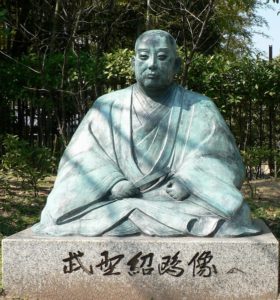
Takeno Jōō (武野 紹鴎) was the successor of Murata Jukō’s wabicha style of the Japanese tea ceremony.
He was born in 1502 in what is now Nara prefecture.
After some time his family moved to the city of Sakai, which was very prosperous at the time.
They became very wealthy as leather merchants.
When Jōō was a young man, he traveled to Kyoto to further his studies.
He learned waka (Japanese poetry) from Sanjōnishi Sanetaka (三条西 実隆), an authority on the subject.
His mastery of waka had an impact in the future development of the tea ceremony.
He returned home to Sakai when he was 31.
Later on Jōō studied under the Rinzai school of Zen Buddhism. His teacher was Dairin Sōtō (大林 宗套) from Daitoku temple.
Regarding his education on the tea ceremony, one source says that he learned from Fujita Sōri (藤田 宋理). Another source mentions that he studied under two teachers, Jūshiya Sōchin (十四屋 宗陳) and Jūshiya Sōgo (十四屋 宗悟).
Perhaps he learned from all three of them. Anyway, they were students of Murata Jukō.
Although Jōō wasn’t a direct pupil of Jukō, he is considered to be his successor because he further developed the wabicha style of the tea ceremony.
Wabi sabi, a concept that finds beauty in imperfection and impermanence, comes from waka poetry. And of course Jōō was very well versed in it.
Jukō had the concept in his tea ceremony, but the word wasn’t used at the time. It was Jōō that explicitly mentioned it.
There’s even a letter from him about it: the Wabi no Fumi.
In his tea rooms, Jōō used even smaller areas than Jukō. He also emphasized simplicity, so that unadorned utensils were preferred.
This continued the trend of favoring the simple Japanese utensils over the expensive Chinese ones.
Jōō’s most important pupil was Rikyū, another wealthy merchant from Sakai, who became the most famous tea master in the history of the Japanese tea ceremony.
As a result, the city of Sakai would be considered the main center of the tea ceremony in Japan for many years.
Jōō died in 1555 from natural causes when he was 54 years old.





March 7, 2018
Nice post. Thank you.
March 30, 2018
Hi Ricardo,
As a fan of history, tea and yourself, it would be great if there was a “family tree” showing the lineage of these famous tea masters. You could add links to their names, so clicking would result in opening the specific blog post about them.
Anyway, please keep your wonderful work. I’m planning on selling tea myself and your site is an excellent resource. I’m also considering going to a tea ceremony classroom. Fortunately, there is one just around the corner from where I live. (Takarazuka, Hyogo Prefecture)
March 31, 2018
Hi Andrew, thanks for your comment.
Your suggestion is very interesting, I will think about how to implement it.
I wish you much success with your tea activities.